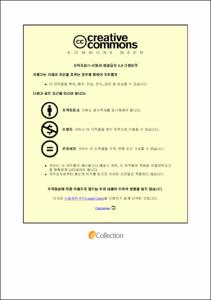Ulsan Univ. Repository
Thesis
General Graduate School
Materials Science & Engineering
1. Theses (Master)
화학적 조성과 소결 조건이 Ni-Mn-Co-O 세라믹스의 미세구조와 전기적 특성에 끼치는 영향에 대한 연구
- Alternative Title
- The effects of Chemical Composition and Sintering Conditions on the Microstructure and Electrical Properties of Ni-Mn-Co-O Ceramics
- Abstract
- 서미스터(Thermistor)는 Thermally sensitive resistor의 약어이며, 환경의 온도의 변화에 따라 서미스터의 전기저항이 변화하는 열민감성 저항체를 표현한 단어이다. 서미스터는 온도 변화로 인한 저항값의 변화에 따라 분류된다. 첫번째는 온도가 상승함에 따라 그 전기저항 값이 감소하는 음의 온도계수를 가지는 NTC(Negative temperature coefficient of resistivity) 서미스터, 두번째는 온도가 상승함에 따라 전기저항이 증가하는 양의 온도계수를 가지는 PTC(Positive temperature coefficient of resistivity), 특정 온도 영역에서 전기저항이 급격히 변하는 CTR(Critical temperature resitor)로 크게 3가지로 분류할 수 있다. 이 중 NTC 서미스터는 저항의 온도 계수가 커서 온도 변화의 정밀 측정, 미소 온도의 측정이 용이하다. 또한 빠른 응답 속도와 높은 신뢰성을 가져 온도 센서, 습도 및 풍속 센서, 자동차 및 산업기기 등에 주로 사용되고 있다. NTC 서미스터는 대부분 Mn, Ni, Co, Cu, Fe 등의 전이금속으로 이루어져 있는 AB2O3의 스피넬 구조를 띈다. NTC 서미스터 중, Ni-Mn 계열의 산화물이 상온에서 낮은 상온 저항으로 인하여 상온에서 작동하는 장치에 광범위하게 사용되고 있다. 일반적인 전이금속의 산화물은 높은 저항을 가지지만, 원자가 전자가 하나만 차이 나는 전이금속 이온들의 전자가 다른 이온으로 전이하여 전하가 변화하는 호핑 효과로 인해 전도성을 띄게 된다. 그렇기 때문에 NTC 서미스터의 특성은 조성에 크게 영향을 받으며, 그 외에도 첨가제, 소결 조건, 결정 구조 및 2차상의 생성 등의 여러가지 원인들에 영향을 받는 것으로 보고되고 있다. 본 연구에서는 NiMnCoO4계 NTC 세라믹스의 조성 비율을 Ni 함량 고정, Co 함량 고정, Mn 함량 고정으로 하는 3가지 조건과 9가지 조성 비율을 다음과 같이 NixMn2-xCo1O4 (0.2≤ x ≤1.8), NiyMn1Co2-yO4 (0.2≤ y ≤1.8), Ni1Mn2-zCozO4 (0.2≤ z ≤1.8)로 변화하여 제작한 시료들의 전기적 특성, 결정구조, 미세구조의 변화를 관찰하여 비교 분석하였다. 또한 다양한 조성비의 NTC 세라믹스의 소결 조건을 다음과 같이 1100 ~ 1300oC의 소결 온도에서 각각 소결한 시료들에 대한 전기적 특성, 결정구조, 미세구조의 변화를 관찰하여 소결 조건의 영향을 확인하였다. 그 결과로 NixMn2-xCo1O4 (0.2≤ x ≤1.8), NiyMn1Co2-yO4 (0.2≤ y ≤1.8), Ni1Mn2-zCozO4 (0.2≤ z ≤1.8) 각각의 조성의 특성을 비교하여 Ni함량, Co함량이 작을 때(Mn 함량이 높을 때), 높은 소결성과 치밀한 미세구조, 안정적인 전기적 특성이 나타났다. 또한 소결 온도가 소결성 및 전기적 특성에 비교적 영향이 작음을 확인하였다. 이러한 결과로 다양한 특성의 Ni-Mn-Co계 NTC 서미스터를 제작할 수 있어 더 많은 분야에서 응용이 가능할 것이라 생각된다.|Thermistor, short for “Thermally sensitive resistor” is a term that represents a thermally sensitive resistance element that undergoes a change in electrical resistance based on variations in environmental temperature. Thermistors are classified according to the changes in resistance values due to temperature variations. Firstly, there is the NTC(Negative Temperature Coefficient of resistivity) thermistor, which has a negative temperature coefficient, causing its electrical resistance to decrease as the temperature rises. Secondly, the PTC(Positive Temperature Coefficient of resistivity) thermistor exhibits a positive temperature coefficient, leading to an increase in electrical resistance with rising temperature. The third category is the CTR(Critical Temperature Resistor), where electrical resistance undergoes a significant change within a specific temperature range. Among these, NTC thermistors are preferred for precise temperature measurements due to their high temperature coefficient of resistance, enabling accurate measurement of small temperature changes. They are commonly employed in temperature sensors, humidity and wind speed sensors, as well as automotive and industrial equipment, owing to their fast response time and high reliability. NTC thermistors are typically composed of transition metals such as Mn, Ni, Co, Cu, and Fe, arranged in a spinel structure of AB2O3. Specifically, Ni-Mn-based oxides within NTC thermistors are extensively used for devices operating at room temperature due to their low room temperature resistance.
In this study, the composition ratios of NiMnCoO4-based NTC ceramics were varied under three fixed conditions: Ni content fixed, Co content fixed, and Mn content fixed. Nine different composition ratios were produced, such as NixMn2-xCo1O4 (0.2≤ x ≤1.8), NiyMn1Co2-yO4 (0.2≤ y ≤1.8), and Ni1Mn2-zCozO4 (0.2≤ z ≤1.8). The electrical characteristics, crystal structure, and microstructure changes of these samples were observed and compared. Additionally, the influence of sintering conditions on the electrical characteristics, crystal structure, and microstructure changes of NTC ceramics with various composition ratios was investigated at sintering temperatures ranging from 1100 to 1300oC.
As a result, it was observed that NixMn2-xCo1O4 (0.2≤ x ≤1.8), NiyMn1Co2-yO4 (0.2≤ y ≤1.8), and Ni1Mn2-zCozO4 (0.2≤ z ≤1.8) exhibited superior properties, such as high sinterability, dense microstructure, and stable electrical characteristics when Ni content and Co content were low(and Mn content was high). Furthermore, it was noted that sintering temperature had a relatively minor impact on sinterability and electrical characteristics. These results suggest the potential application of Ni-Mn-Co-based NTC thermistors with diverse characteristics in various fields.
- Issued Date
- 2024
- Awarded Date
- 2024-02
- Type
- Dissertation
- Alternative Author(s)
- Park JaeYoung
- Affiliation
- 울산대학교
- Department
- 일반대학원 첨단소재공학과재료공학전공
- Advisor
- 이재신
- Degree
- Master
- Publisher
- 울산대학교 일반대학원 첨단소재공학과재료공학전공
- Language
- kor
- Rights
- 울산대학교 논문은 저작권에 의해 보호받습니다.
- Appears in Collections:
- Materials Science & Engineering > 1. Theses (Master)
- 파일 목록
-
-
Download
 200000738047.pdf
기타 데이터 / 5.46 MB / Adobe PDF
200000738047.pdf
기타 데이터 / 5.46 MB / Adobe PDF
-
Items in Repository are protected by copyright, with all rights reserved, unless otherwise indicated.